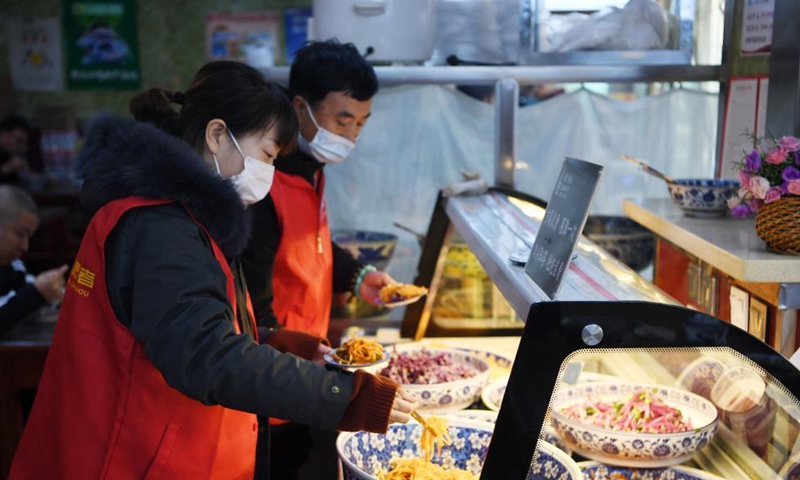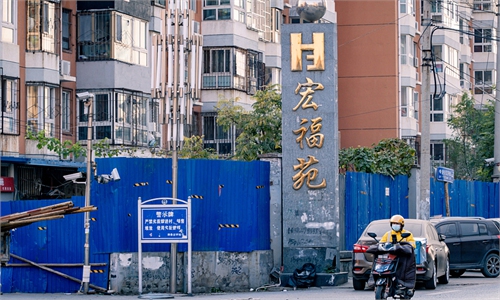Latest COVID-19 resurgence triggered by new imported Delta variant source
Current wave spreads to 11 provinces, 'could be tamed in one month'

Authorities seal off the Xi'erli compound in Haidian district, Beijing on October 22, 2021 after a COVID-19 patient was found to have been to the compound. Beijing on October 22 registered four new infections, bringing the total to six in the latest resurgence that involves 10 provinces and regions. Photo: VCG
The latest COVID-19 resurgence, which has spread into 11 Chinese provinces in just one week, was triggered by a new imported source identified as being of the Delta variant, according to officials from China's top health authority. Some Chinese epidemiologists see the current sporadic outbreaks hit the largest scale since the epidemic flare-up in Nanjing in late July that was the worst since the 2020 outbreak in Wuhan, Hubei Province.
However, if anti-epidemic measures are effectively implemented and loopholes are fixed, the latest outbreaks can be brought under control within one month, a veteran expert said.
Of the 133 infections reported over the past week, 106 cases were found to be related to tourist activities involving a total of 13 tour groups or self-driving tours, Wu Liangyou, deputy director of the National Health Commission (NHC) disease control bureau, told a briefing on Sunday.
At present, the epidemic is in the rapid development stage, as cases of infections that are not related to tour groups have been increasing. As screening work continues, the number of infections is anticipated to increase, with the areas affected also expanding, Wu said.
Ejin Banner in North China's Inner Mongolia Autonomous Region has come under the spotlight amid the latest epidemic resurgence, as almost all the domestically transmitted cases were part of tour groups traveling to the county-level division in the region that borders Mongolia, the latest transmission chains showed.
Since October 17, the new round of domestic infections has occurred in multiple places and spread to 11 provinces within one week. Most of the infections are related to cross-regional tourism-related activities and the risks of the epidemic further expanding have been increasing, according to the NHC.
Imported source
Based on the epidemiological investigations and the existing virus sequencing results, China's top health authority has identified the current virus genome sequence as sharing low homology with those of the previous outbreaks in China, suggesting that the ongoing resurgence was caused by a new imported source. The virus was also identified as being of the Delta variant and appeared to be highly contagious, causing continuous transmission in highly exposed groups.
It has been confirmed that the virus that resulted in the ongoing outbreaks came from overseas, but how it entered China remains unknown, Wang Guangfa, a respiratory expert at Peking University First Hospital, told the Global Times on Sunday. However, it's worth noting that Ejina Banner is at the intersection point of different transmission chains where the China-Mongolia port is located, he said.
Some health experts reached by the Global Times in earlier interviews also said that possibilities of confirmed cases becoming infected in the port cannot be ruled out, given the epidemic overseas has not been fully contained.
"It's getting cold in northern regions, which means the virus can exist longer on the surface of objects or in different environments. There is also evidence showing cold-chain system is helping transmit the virus," Wang said, noting that all these factors need to be taken into consideration.
Li Mingde, an academic adviser at the Tourism Research Center under the Chinese Academy of Social Sciences, told the Global Times on Sunday that this round of epidemic resurgence demonstrates that tourism is a key channel for virus transmission, as it always comes with clusters and huge flows of people across the country.
With Northwest China's Gansu Province suspending all tourism-related activities amid increasing COVID-19 infections, as of Sunday, at least five provinces including Beijing halted cross-provincial tourism-related activities after the Ministry of Culture and Tourism issued a new announcement on Saturday requiring travel agencies, in a circuit-breaker measure, to suspend cross-provincial tourism-related activities in places where medium- or high-risk areas are located and announced.
Adopting a circuit-breaker mechanism in the tourism industry amid an epidemic complies with China's zero-tolerance policy, and is an emergency measure to ensure that virus transmission can be promptly cut off and tamed, Li said.
The ministry also advised the public not to go to medium- and high-risk areas and said travel agencies must strictly control the size of tour groups. As of Sunday, eight provinces and municipalities have come up with new tourism policies. Beijing, for example, urged the public to reduce public gatherings, while Southwest China's Yunnan Province banned travel groups from going to provinces that have medium- and high-risks areas.
The latest sporadic outbreaks have become the severest after the outbreak in late July in Nanjing, capital of East China's Jiangsu, Wang said, noting that transmission chains among tourist groups have been expanding into more places with the numbers of infections continuing to increase.
The outbreak at Nanjing Lukou International Airport, which was also triggered by the Delta variant, was the most severe and caused the most infections in China since the outbreak in Wuhan in 2020, according to the NHC.

COVID-19 prevetion and control volunteers dine at a noodle restaurant in Lanzhou, northwest China's Gansu Province, Oct. 22, 2021.Photo:Xinhua
Possible inflection point
Taking into consideration the risks of a COVID-19 resurgence and seasonal flu posing challenges to anti-epidemic work in the autumn and winter seasons, the NHC urged the public to enhance immunity by taking booster shots of the COVID-19 vaccines. As of Saturday, 2.24 billion doses of COVID19 vaccines have been administered across China.
Meanwhile, a number of cities and districts have been tightening epidemic prevention measures in recent days. Beijing announced on Sunday the imposition of entry control measures, barring anyone from places that have reported at least one new domestically transmitted case or anyone who had a 14-day travel history to those places from entering the capital city.
Beijing's Changping district, which reported 10 domestically transmitted COVID-19 cases in the past two days, has further tightened its anti-epidemic measures, with all chess and card rooms in the district being closed and several pharmacies shutting down where epidemic prevention measures were not in place.
Ejin Banner announced harsh punishments against six officials, including heads of the local health commission, on Saturday for their slack response and ineffective management, becoming the first city to punish officials since the emergence of the latest COVID-19 flare-up in multiple places.
In addition to the strict epidemic prevention measures, Chinese health officials vowed to accelerate the mass vaccination drive, particularly aiming to enhance immunity through booster shots among vulnerable groups. Those above 18 years old and who have received two vaccine doses are eligible for booster shots, Wu from the NHC said.
While the booster shot plan is being launched, authorities are demanding that more high-risk groups be included in the groups for enhanced immunity, including staff working at ports, border inspection posts, quarantine locations and those attending major activities or planning to go overseas for study or work, as well as those above 60 years old who have a higher risk of being infected.
"When we talk about the inflection point for an outbreak, we usually need seven to 14 days to see if the outbreak can be tamed. If not, it shows that the epidemic measures are not being effectively implemented and loopholes exist," noted Wang the epidemiologist.
"If all the epidemic prevention measures are strictly carried out, the outbreaks can be cleared within one month," he said.





